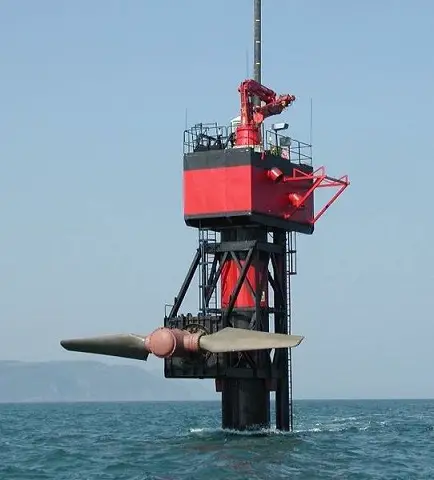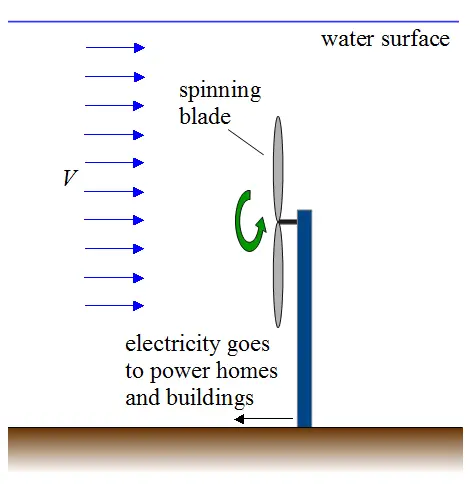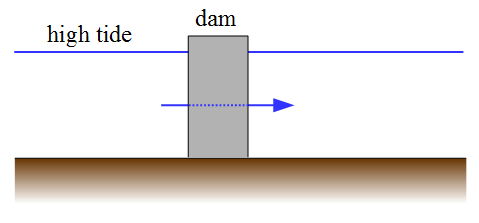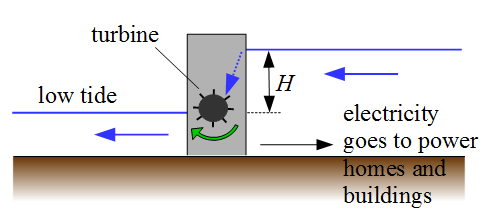About me and why I created this physics website.
Tidal Energy - For Kids

Tidal turbine raised out of the water. Source: http://en.wikipedia.org/wiki/SeaGen. Author: http://commons.wikimedia.org/wiki/File:Seaflow_raised_16_jun_03.jpg
Tidal energy is the energy from the bulk movement of water due to tides. This energy results from the rise and fall of the water level in large bodies of water. Tides are commonly semi-diurnal (two high waters and two low waters each day), or diurnal (one high water and one low water each day). This rise and fall of water level is due to the rotational motion of the earth relative to the moon, and to a lesser extent, the rotational motion of the earth relative to the sun. As the earth rotates, the gravitational force between the earth and moon, and to a lesser extent, the earth and sun, causes periodic changes of water level which in turn causes tidal currents. These currents can then be used to generate power. In this sense it is similar to how wind power is generated. However, water is 800 times denser than air, so water moving at a certain speed has a lot more energy than air moving at the same speed. As a result, a flow of water will generate much more energy than a flow of air moving at the same speed.
The figure below shows the bulk movement of water past an underwater turbine. This movement of water turns the turbine blades which then generate electricity for use in homes and buildings. The faster the velocity of the water V, the faster the turbine rotates and the more energy is produced.
The tidal turbine blades are like propellers on airplanes that are running in reverse. When an airplane engine rotates the propeller, the propeller "pushes" the air and the air moves as a result. It does this because of the tilted angle of the propeller blades. In this case the air is reacting to the rotation of the propeller. For a tidal turbine, the moving water pushes on the turbine blades, which causes them to rotate. In this case the turbine blades are reacting to the motion of the water.

This type of tidal generator can also be used in areas where water flow is not a result of tides, such as the entrance to bays and rivers, or between land masses where water flow is concentrated. These type of naturally occurring flows are constant year round. They are referred to as marine currents.
Another way to harness tidal energy is with a tidal barrage, shown below. A tidal barrage is a type of dam which operates on the same principle as a hydro-electric dam. It takes advantage of the difference in water height between high tide and low tide. As the water height increases inside a closed body of water, such as a bay, it flows through a barrage which lies across the width of the bay. The water flows through the barrage because gates in it are opened allowing water to pass through.

Once high tide is reached (corresponding to the greatest height of water reached), the barrage gates are closed. This traps the water behind the barrage. Then, as the water height decreases towards low tide, the water height behind the barrage stays at the original level. This results in a difference in water height H, as shown below. Once the height difference H is large enough, water is allowed to flow through the barrage and through turbines. This turns the turbine blades which generate electricity for use in homes and buildings.

The barrage is able to generate electricity in this way as long as the height difference H is large enough. But as the body of water behind the barrage empties out, the height difference H decreases until it is equal to the water height on the other side of the barrage. At this point no more electricity can be generated until the tide rises again, and the process is repeated.
Return to Physics For Kids page
Return to Real World Physics Problems home page